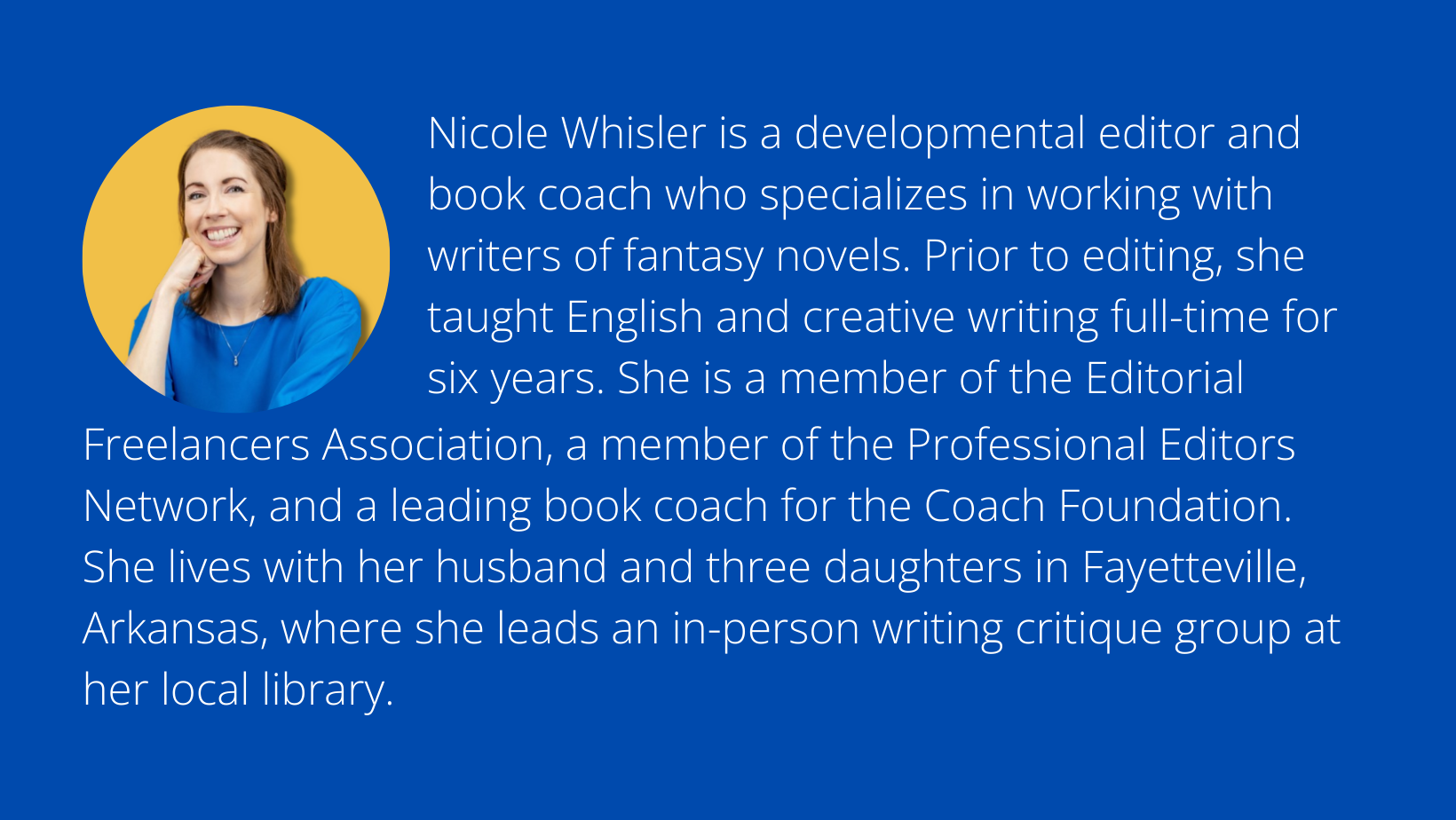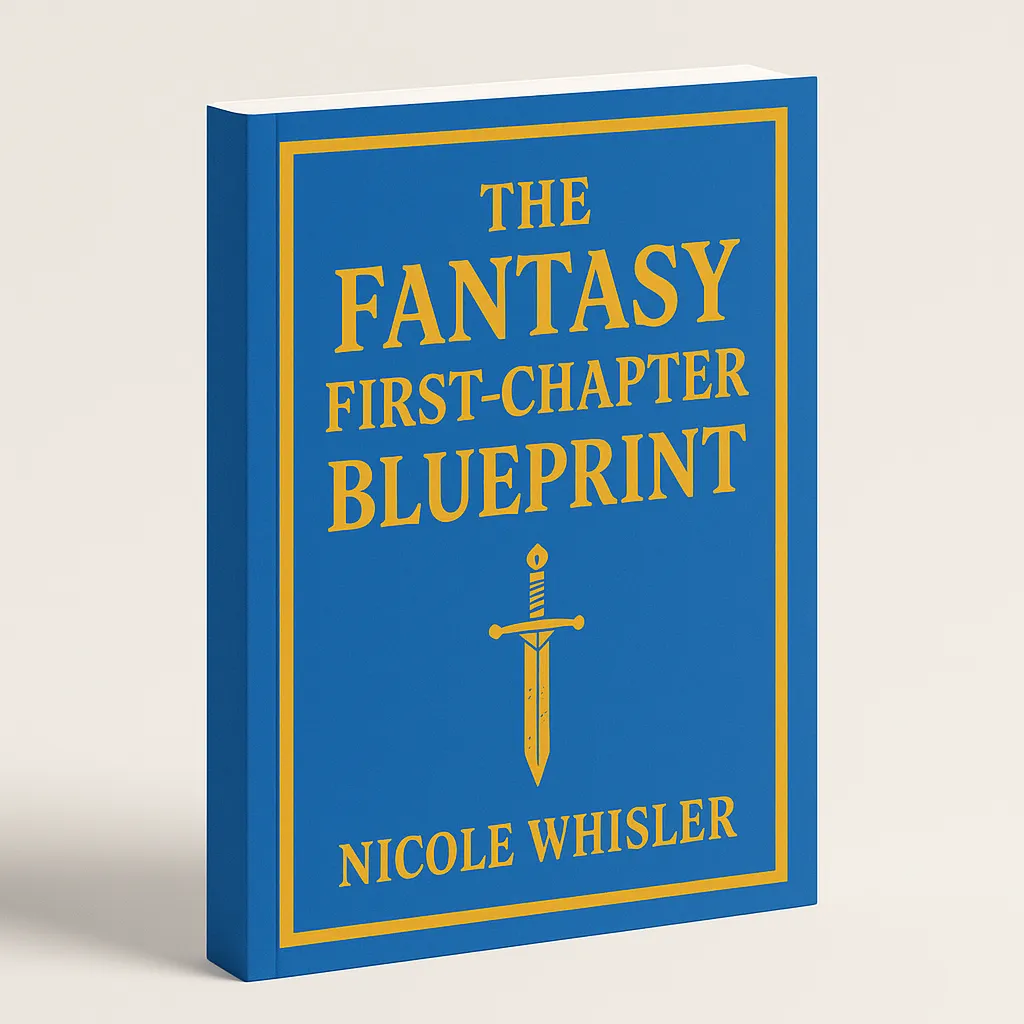The Fantasy First-Chapter Blueprint
Your first chapter is your one shot to hook an agent or a reader. Don't let the 7 deadliest mistakes land your manuscript in the rejection pile. This free 7-day email course gives you the step-by-step blueprint to avoid them and craft an irresistible opening.

Your Novel Matters ...
Looking for the right book coach for your fantasy novel?
Are you a fantasy writer …
… struggling to convert the vivid scenes of your fantasy novel from your imagination to the page?
… stuck in a loop where you constantly rewrite your opening pages?
… worried your story won’t resonate with your readers?
What if I could show you the exact steps week to week that would take you from brainstorming and drafting to revising and publication?
I specialize in developmental editing and book coaching for writers of fantasy novels—writers who value the craft of storytelling and wish to create stories that resonate.
My Services
Develop Your Ideas
Fantasy Footsteps: Road to Publication

I’ll let you in on a secret. All you need to succeed as a writer are three things:
A Roadmap: Illuminate your path with a step-by-step guide, ensuring you achieve your writing goals every week. From outlining to publishing, every stage of your journey is mapped out for success.
Mindset Mastery: Learn how your thoughts control your outcomes in your writing. Overcome self-doubt and unearth the confidence that will bring your unique ideas to life on the page.
Personalized Support: Prepare for comprehensive assistance, real-time accountability, and feedback tailored to your needs. From brainstorming sessions to final publication, you'll have a dedicated ally guiding you every step of the way.
With these three pillars, you'll unlock the potential to:
Craft a captivating story that enthralls readers from the first page to the last.
Develop complex characters and immersive worlds that resonate deeply with your audience.
Navigate the complexities of plot twists and pacing, keeping readers hooked until the final chapter.
Receive specific guidance on refining your scenes so that readers root for your protagonist.
Overcome writer's block and stay motivated throughout your writing journey, ensuring consistent progress.
Transform your rough draft into a polished, professional manuscript ready for publication.
Are you ready to turn your fantasy novel from a mere vision into a masterpiece that captures hearts and minds?
Join Fantasy Footsteps: Road to Publication and begin your author journey with everything you need to write a story that works.
Don't let your story remain trapped in your mind—bring it to life with me!
If you’re thinking, “Yes, please! Tell me what to do!” , I’d like to invite you to work one-to-one with me to finish your novel and write a story that works. Join my book coaching program designed specifically for fantasy writers—Fantasy Footsteps: Road to Publication.

Discover Helpful Tools
Resources For Writers
Here you will find some of my favorite resources for writers.
Add these books, podcasts, websites, and other resources to your writing toolbox to augment your writing at any stage.
Join My Free, Private Facebook Group
Finish My Fantasy Novel: Write & Revise My Best Book in 6 Months
In the group, I go live weekly with writing tips. The group is also a platform for writers to support each other and share their wins and progress.
Live training schedule:
1st Tuesday of the month: Free critique for someone in the group!
2nd Tuesday of the month: Writing sprint with fellow writers
3rd Tuesday of the month: Live training on a specific topic
4th Tuesday of the month: Interview with an author or marketing/business expert


Improve Your Craft
Writing Advice Blog
As a developmental editor and book coach, everything I post is designed to help you build your creativity, strengthen your prose, and explore new avenues in your writing. The opinions in each post are my own, but many are inspired by ideas from established authors and editors who excel in their fields.
Rely on my blog for clear and specific writing advice, motivational tips and grammatical aid, and interviews with experts!
Hi! I'm Nicole.
I’m a Developmental
Editor & Book Coach for Fantasy Writers.
Like you, I'm a writer. I understand the mental and emotional ups and downs of storytelling. Don't let resistance win! Recognize the value of good advice plus hard work.
My approach to novel writing is multifaceted. For a deeper understanding of my process and style, take a look at some of my favorite craft-of-writing books in my Resources section.
What can I say about myself? I read, I write, I read about writing, and I write about reading. It never gets old to me.

See what writers like you are saying . . .

Nadir Shirazi
“I’ve been stalling on my Islam-inspired sci-fantasy series for 10 years. But within 10 minutes of starting Nicole’s program, I started writing again."

Amanda Emerick
“I can’t recommend Fantasy Footsteps enough to writers who are legitimately looking to polish their craft, write, and eventually publish their novel."

Trinity Cunningham
“I loved discussing my story with Nicole. She provided me with invaluable insights I never would have considered on my own."
Latest on the Blog

You will find no pictures of kittens here. No images of favorite dessert recipes, snapshots of my recent vacations, videos of puppies playing the piano (although I do love dogs), or YouTube clips of monkeys stealing people’s sunglasses.
I’m genuinely sorry if that disappoints you.
Instead, you can rely on my blog for clear and specific writing advice, motivational tips, grammatical aid, and author/editor interviews.
As a developmental editor & book coach, everything I post is designed to help you build your creativity, strengthen your prose, and explore new avenues in your writing. The opinions in each post are my own, but many are inspired by ideas from established authors and editors who excel in their fields.
Some of these tips might be just what you need to hear. Others might not work for you personally, and that’s okay.
Apply the tips that fit your personality and writing habits, and feel free to adapt or ignore the others. For further questions and comments, you can email me or reach me through my Contact page.

How to Get Into Your Character's Head without Using Italics
Discover in this post …
the primary reason readers stop reading a book.
the most effective way to resolve a lack of character–reader connection.
specific examples that illustrate exactly how to strengthen that connection.
Don't Let Readers Close Your Book
As a book coach for fantasy writers, I’ve worked with many authors to address common first-draft issues.
Plot holes. Lack of believability. Low stakes. Unbalanced exposition.
But I’ve found one item that appears more frequently than any other in early chapters. One item that automatically turns readers away, whether readers realize why they’re closing the book or not.
More than anything else, readers stop reading when they don’t connect with the protagonist. If they feel emotionally distant from your hero, they’re not likely to read on.
Contrary to what some writers think, readers don’t need to be similar to your protagonist to connect with them. They don’t need to share a hobby with your character, find a mutual personality trait, or even have age in common.

All they need is a deep dive into your point-of-view character’s head so they can understand who your character is.
If they understand your character, they can root for your character. They’ll see why the events of the plot matter and why they should invest themselves in the rest of the story. They’ll feel for your character as deeply as you do.
So how do we get into our point-of-view character’s head? One strategy is to use direct thoughts. Here’s an example:
No, she thought. It doesn’t matter anymore.
To be clear, there’s nothing grammatically incorrect about this use of italics. Writers have italicized direct thoughts for many years, and if used sparingly, especially for short, punchy statements, italics can work well.
Italics aren’t especially effective for lengthy thoughts:
No, Fiona thought. It doesn’t matter anymore. Ever since I confronted Harold in the dining room, everything has gone topsy-turvy. I wonder if he even loves me after what I did. I wouldn’t love myself if the tables were turned.
Lengthy italicized texts aren’t visually appealing, and readers don’t usually enjoy slogging through them. Instead, you could drop the italics, adjust the tense as necessary, and write something like this:
It didn’t matter anymore. Ever since Fiona had confronted Harold in the dining room, everything had gone topsy-turvy. Did he even love her after what she did? She wouldn’t love herself if the tables were turned.
Do you see how we’re in Fiona’s head, getting her thoughts without the italics? We’re in deep third-person point of view, so it isn’t necessary to say, “Fiona thought this” and “Fiona thought that.” We can simply state her thoughts themselves.
Until I started working one-to-one with fantasy writers, I didn’t realize how many writers were unsure how to get into their character’s head without using italics. I thought I’d take this opportunity to demonstrate how this can look.
Examples from a Middle Grade Fantasy Novel

On the first Tuesday of every month, I conduct a live critique on an opening scene submitted by a fantasy writer in my free, private Facebook group. One of these writers was gracious enough to allow me to use pieces of his middle grade fantasy novel as an example in this post.
I loved immersing myself in the writer’s opening chapter. Here’s a passage from his work in progress:
There had been weeks of dreary rain over the summer holidays, and school was about to start again. A bored Charlie was sitting at the dining table under the living room window, gazing out into the street, his chin nestled in his hands. He was deep in thought as he surveyed the hypnotic stream of water flowing along the street.
The story then moves on to describe Charlie’s mother coming home. Since the writer of this passage intended for his scene to be told from a close third-person point of view, I encouraged the writer to pause before moving on with the action. In this paragraph, we have an excellent opportunity to close the distance between readers and Charlie and get deeper into Charlie’s head. To get to know Charlie better, I want to know what makes Charlie bored. What is he deep in thought about? Is he bored because he loves to be outside? Because he misses his friends from school? Is he thinking about his dad’s disappearance (mentioned in the paragraph prior in the original submission)? Or how his plans for the rest of the summer are foiled because of the rain?
It may seem obvious, but whatever your character is thinking about will direct your readers’ focus. You get to choose when—and how often—to let readers into your point-of-view character’s interior world. Exposing their inner thoughts and reactions will tell readers who your character is at their core.
I’ve taken some creative liberties with the storyline, but here’s one way to rewrite the above passage to show Charlie’s thoughts without bogging down the paragraph with a jumble of italics:
There had been weeks of dreary rain over the summer holidays, and school was about to start again. Charlie sat at the dining table under the living room window and gazed out into the street, his chin nestled in his hands. Could his dad be out there, watching the same hypnotic stream of water flowing along the street? Or was he long gone? Mum said they’d never see him again, but Mum lied an awful lot. Either way, his dad would almost certainly miss another of his first days of school. Charlie counted. Was it three already? Three years without his dad squeezing his hand and saying, “Make it a good one, son”?
Something heavy—pointy and sharp like a rock—settled in Charlie’s chest. Maybe if he did the dishes when Mum asked him. Dropped his clothes in the laundry basket instead of on the floor. Said “I love you” to Mum more often, even when she snapped at him. Maybe then Dad would come back.
As I said, I’ve taken creative liberties with this passage. It might not be the writer’s intention to highlight the way Charlie misses his dad. But that’s the point! That’s the topic that stood out to me as I read this writer’s scene, so that’s what I chose to emphasize in the above rewrite. The writer can make a choice that’s aligned with his intention.
In this rewrite, readers know exactly what Charlie is thinking, so that instead of saying, “Charlie was deep in thought,” we know what he’s thinking about. This helps us understand his voice and feel connected to him. (One caveat: You don’t need to tell readers every thought on Charlie’s mind at every moment throughout the entire story. That would become a slog of its own. But I’ve found the opposite problem is much more common, which is why I’ve chosen to address it.)
Here’s a second example from the same middle grade fantasy manuscript—an argument between Charlie and his mother:
“So, can you explain how this has just 'literally' come through the letterbox when I’ve been sitting out in the car for the last few minutes talking to Maureen? I certainly didn’t see anyone pass by. Is this some kind of joke?” his mother said, raising her voice.
Charlie let out a sigh.
After this passage, Charlie’s mother continues to berate him, but Charlie’s personality and voice are minimized because I’m not clear on his reaction beyond the sigh. On one level, the sigh speaks for itself. It seems as if he’s tired of his mother’s nagging. But because I’m not privy to Charlie’s thoughts in the rest of the scene, I can’t say for sure. I don’t know if he’s angry, annoyed, or just feeling misunderstood.
Sometimes, especially in a high-stress situation like a fight scene, it's appropriate to save the bulk of the character's emotional reaction for after the fact. But in general, I recommend putting your character's thoughts on the page in real time so that readers can watch your character respond to a specific trigger in a natural way.
Here’s one way to rewrite the above passage so that Charlie’s inner world isn’t so hazy:
“So, can you explain how this has just 'literally' come through the letterbox when I’ve been sitting out in the car for the last few minutes talking to Maureen? I certainly didn’t see anyone pass by. Is this some kind of joke?” his mother said, raising her voice.
Charlie let out a sigh. Mice would eat cats before she ever let him be. Last week it was his dirty socks on the chaise lounge. Today it was the letter—which he’d had nothing to do with. He had half a mind to snap back at her and see how she liked it, but he wouldn’t. Of course he wouldn’t. That was the thing he knew clear as day about himself: he’d never be the one to stir up worse trouble. Trouble liked him well enough already.
With the added information, we have a stronger understanding of the dynamic between Charlie and his mother. We also know more about Charlie as a character and have a deeper sense of who he is as a person. Each insight we gain attaches us to him more firmly and prompts us to keep flipping those pages because we care about Charlie’s story.
Your Turn

Want to try this for yourself? Choose a few chapters you’ve written and highlight all the times you’ve already gotten into your point-of-view character’s head. Find a passage where that’s sparse, then use the above examples as a guideline as you sprinkle in your character’s thoughts. Remember that the thoughts shouldn’t be random. They should help direct your readers’ attention to what’s important in the scene, and they should provide readers with a clearer sense of who your character is and why readers should root for them.
For related content and additional examples, see my blog posts on character voice and character reaction.
I hope you’ve enjoyed today’s post about strengthening the emotional bond between readers and your protagonist. If you try the activity above, I’d love for you to email me at [email protected] and let me know how it went! I love building community with writers and readers, so never hesitate to reach out. (After all, if I’m not in your head, how will I ever know what you’re thinking?)
Do you want to learn how to write a story that makes your target readers stand up and cheer? If you’d like support from A to Z (from brainstorming to drafting to revising to publication), book a Discovery Call with me to see if you’re a good fit to join my book coaching program, Fantasy Footsteps: Road to Publication. And if you haven’t done so already, grab your Free Guide on how to hook readers from your story’s start!

Capture Your Readers from Your First Scene
Get my exclusive blueprint—7 Mistakes to Avoid in Your Fantasy Novel’s Opening. Start your fantasy novel right!
Are you worried you've failed to establish a bond between readers and characters in your first chapter? Do you wonder if you've bogged readers down with your worldbuilding? Do you sometimes overlook essential conflicts? Many readers will put your book down if it doesn't grab their attention right away, so it's vital to evoke powerful emotions from readers as early as possible.
Don't let these common mistakes rob your story of its magic and momentum. Save your precious time and energy by ensuring you hook readers from the start. Grab your guide now and check your opening against these common missteps!
(You will also receive monthly writing advice, updates about my free live trainings, and direct access to replays. Unsubscribe anytime.)

